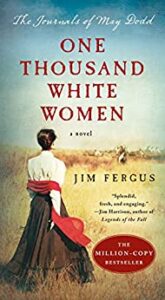By Jim Fergus
 This novel is presented as a supposedly historical diary written by May Dodd, beginning around 1873, as she became part of a secret federal program to assimilate Native Americans by giving them 1,000 white women as brides.
This novel is presented as a supposedly historical diary written by May Dodd, beginning around 1873, as she became part of a secret federal program to assimilate Native Americans by giving them 1,000 white women as brides.
May was born into a wealthy Chicago family, but disgraced them by running off with one of her father’s employees of unsuitable social standing. She had two children without the benefit of a wedding before her family stepped in. They forced her into the Lake Forest Lunatic Asylum, and kidnapped her two children to be raised by their grandparents.
For May, as for many of her sister “brides,” the Brides for Indians program offered an escape or an opportunity to do something otherwise prohibited by conventional social life. Several women were escaping lunatic asylums like May; the Irish twins Meggie and Susie Kelly are escaping prison sentences for prostitution and theft; the fierce and regal Euphemia Washington, is escaping slavery; the British artist Helen Elizabeth Flight wants an opportunity to paint the birds of the American West but has no funds; Southerner Daisy Lovelace and her poodle, lost everything in the Civil War; and the homely Gretchen Fathauer has no marriage prospects.
The Brides for Indians program was proposed by a Cheyenne chief, Little Wolf, who saw this as the best way for the next generation of Cheyenne to get a successful footing in the encroaching white man’s world.
May’s journal, penciled into leather bound notebooks, offers a view of a world vanishing even as she passed through it. She writes of her marriage to Little Wolf and of the idyllic summer the tribe and the white women spent, living off the land, hunting game and buffalo.
Her diary also documents the perfidy of the federal government, white society and the Army. She describes trains stopping in the middle of the prairie while soldiers and white passengers shoot buffalo, leaving them dying or dead to rot in the sun. The promised thousand white women, of course, never materializes beyond the first hundred or so. Those women find that when the Army decides to launch a massacre, white skin is no protection.
Author Jim Fergus romanticizes Native American life before the reservations. He also is light-handed about the adaptations the women had to make to their new community, families and cultures. Although difficult to read at times, this is an interesting book. A reader would be advised not to make it the only book one reads about this period of history.
Fergus also wrote THE VENGEANCE OF MOTHERS, which explores what happens to the Irish twins Meggie and Susie Kelly after a massacre destroys their home. In particular, it looks at what happens to husbands and wives, children and mothers when society’s racial attitudes label them unspeakable.
It was followed by STRONGHEART, which picks up the story after the battle of Little Big Horn with some female survivors deciding to take up arms against the United States for stealing Native American lands, way of life, culture and history. Their war continues from generation to generation.
About the Author: Jim Fergus (1950 – )
Jim Fergus is a journalist and a novelist. ONE THOUSAND WHITE WOMEN (1999) was his first novel. It won the 1999 Fiction of the Year Award from the Mountains & Plains Booksellers Association.
He earned a degree in English from Colorado College and worked as a tennis teacher and a freelance writer.



